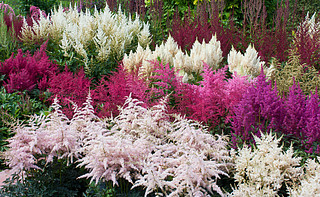Formally known as “the false goat Beard,” Astilbe is a beautiful flowering plant with lots of moisture requirements. Astilbe plants come in different attractive colors ranging from white to red and pink. They have fern-like foliage, and when planted, they can grow as tall as 1.5cm.
plants come in different attractive colors ranging from white to red and pink. They have fern-like foliage, and when planted, they can grow as tall as 1.5cm.
Astilbe grows really tall, so it’s important to divide them regularly. Without dividing them, they will be overcrowded, and that may result in withering. However, dividing an Astilbe plant is very easy, and that is what I will show you in this post.
In this post, you will be shown the step-by-step process involved in successfully dividing an Astilbe plant. These steps are necessary if you want the plant to grow healthier.
Planning the Division Period
Check within 3 to 4 years.
It’s not actually necessary to divide your Astilbe every year. Once every 3 to four years will be okay. When you have noticed its parts clumping up, you can start dividing it as quickly as you can.
When choosing a season to divide your Astilbe, spring will be more favorable to the plant. If the weather is too warm during the summer, dividing Astilbe may kill it. So you need to plan its division during the spring when the temperature is cooler.
Wait until you notice clumps from the Astilbe.
Having several clumps on your Astilbe is a sign that it needs to be divided. If your Astilbe doesn’t have enough clamps, dividing it may not be worth it. You can check for the clumps near the end of the plant.
If you find at least 5 clumps at its base, then it is safe to divide the Astilbe. But if you only have about 2 to 3 clumps, dividing it will be too early for the plant.
Uprooting Astilbe from the Ground
Soften the soil.
Watering Astilbe a few days before dividing it will help in softening the soil. If you can successfully soften and moisten up the soil, the Astilbe will be much easier to divide. You can start watering the plant for 2 or 3 days before uprooting and dividing it.
Get a garden fork and spade.
Cutting the roots may harm the plant, so using a spade can help you reach deep down underneath the plant. If you cannot dig the root without harming it, then you can dig around the plant.
You can dig a trench around the root ball until you can see the root and uproot it.
Pull the plant by the base.
When uprooting the plant, hold it by the base and ensure you pull it with the root ball intact. If the plant is stuck, you can loosen it by gently shaking it or using your spade or fork. Ensure you do so with care in order not to damage the rest of the plant.
Remove the excess dirt.
After uprooting the plant, remove the excess dirt by shaking the plant. You can also use your fingers to remove the dirt that is left on the root ball. If the dirt is too much to remove by hand, you can use a little water to wash them off.
Dividing and Replanting
Use garden shears to divide the crown.
Once you have uprooted and cleaned the Astilbe plant, you can begin the process of dividing it. You can use a pair of garden shears or your fingers to divide the Crown.
To be more specific, you should always focus on the base of the crown when dividing the Astilbe. The crowns have a few stems attached to them, so dividing them into smaller pieces wouldn’t affect them.
Replant your cuttings.
After cleaning and dividing the Astilbe, it will be essential to replant the pieces as soon as possible. This will ensure it doesn’t wither before it gets to the ground.
When replanting the Astilbe crowns, do it on a pot of soil or garden bed. They should all be planted at least 3 feet apart from each other. This will ensure they don’t overcrowd each other when they develop.
Ensure that the area you are planting the Astilbe has minimal access to light. An Astilbe plant is also quick to adapt to water-logged conditions. So ensure you avoid areas with poor drainage.
Add mulch to the soil and water constantly.
The Astilbe plant is a plant that flourishes under moist conditions. So ensure you add a layer of mulch over the soil to maintain its moisture. Also, ensure you water it frequently after planting it. This will be very helpful for the development of the plant.
More Information about the Astilbe Plant
Astilbe has over 25 of its species still in existence. Some are erect, while some grow on arching stems—the popular colors from the flower range from pink, white, and dark purple.
Depending on the Astilbe species you want, they come in different heights. Some grow about 1m tall, while others can grow up to 10cm in height. Apart from growing tall, most Astilbe species always blossom in the summer so that they will be perfect in your garden.
Growing Conditions
An Astilbe plant is one plant that can grow well under a shade. But the flowers in the Astilbe plant can be very productive if they receive a minimal amount of sunlight every day.
Aside from light, the plant also needs enough moisture and good soil to flourish. To keep the soil regularly moist, it’s essential that you water it as often as possible.
Pests and Diseases
Astilbe normally grows in a moist environment, so you don’t need to bother about pests and diseases. However, garden slugs can get to the plant, so ensure you remove them if you notice any.
Watering and Fertilization
Astilbe doesn’t require any fertilization during the growing season. However, you can apply granular fertilizer to it before the flowering season commences. In terms of watering, Astilbe needs a lot of water to flourish.
My wrapping up
The Astilbe plant comes with a lot of beautification for your environment. Although the plant requires minimal maintenance, caring for it and watering it regularly will improve its development.
When the Astilbe plant is properly cared for, it will result in a long-lasting bloom from spring through summer.
Thank you so much for your time reading this article; if you have some comments or something to share here, please kindly leave your comment below, and I’ll be happy to write back to you.
CLAIM YOUR DISCOUNT: As the owner of this website, I’ve tracked down special deals for some of the products and services mentioned herein. When you use the links on this page to make a purchase, I may get a small commission and use it to improve & maintain the website, and you may get a great bargain too. Full disclosure.


Leahrae
Astilbe looks like something I would love to have in my flower garden. I just uprooted some “old lady bushes” that were planted along with my house. I am working on getting all the roots out, and then I would like a nice flowering plant. I do live in Florida, and where I am planting, with getting full sun most of the day. I saw you said they do good in the shade with some sun. Is this plant not good for full Florida sun?
admin
Hello Leahrea,
Thank you so much for your visit and for commenting on How to Divide Astilbe. I’m glad that you like and enjoyed it. Thank you and best wishes,
Joyce